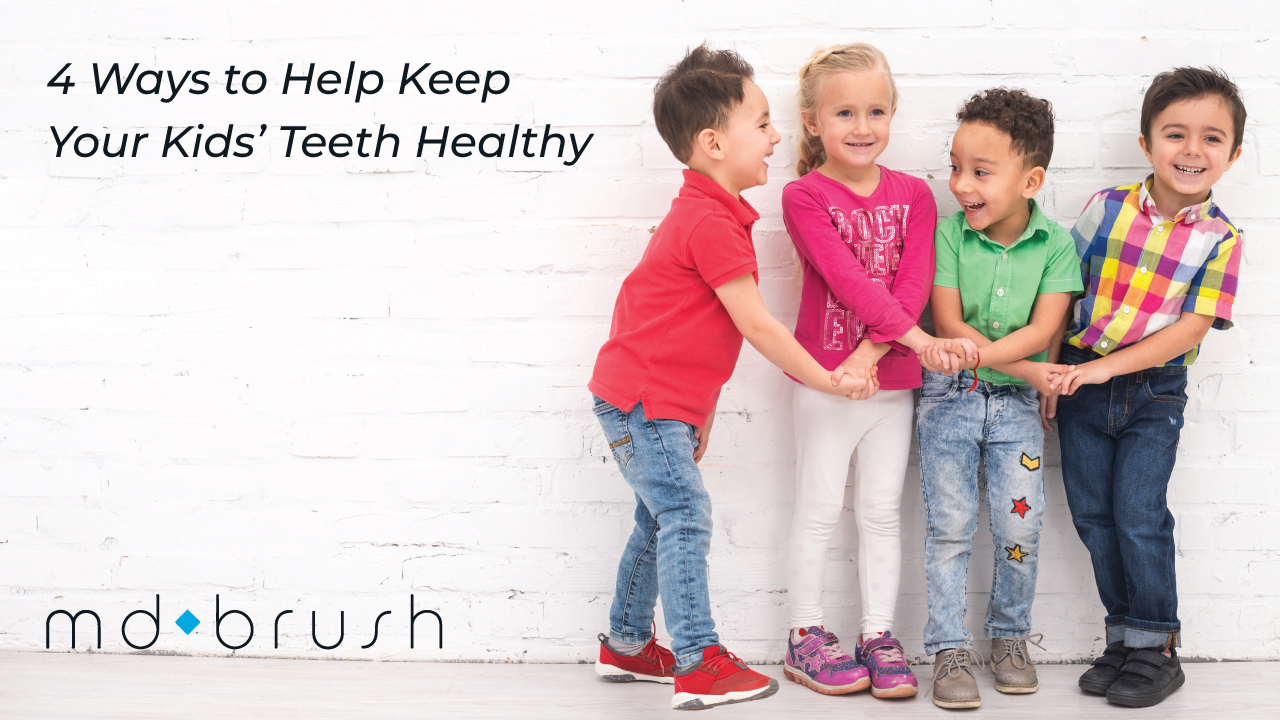4 Ways to Help Keep Your Kid’s Teeth Healthy

February is National Children’s Dental Health Month and we at MD Brush are excited to make sure your children have the right tools to keep their mouths healthy. As kids grow, plan on routine dental checkups every six months, keep sugary foods in check, and encourage good brushing habits. Here are MD Brush’s four tips for keeping your kids’ teeth healthy and happy:
1. Eating A Balanced Diet
It’s pretty simple: reduce sugar and add more fruits and vegetables. Reducing the amount of juice your kids’ drink might sound hard considering that they love juice, but the effects of sugar in the juice aren’t worth it. The sugars or carbohydrates in sugary drinks stick to teeth, combine with bacteria and develop into acids. These acids start to break down enamel and create tooth decay.
It’s especially important to avoid putting down a baby or toddler for a nap with a bottle or sippy cup filled with juice. Even milk or formula has long-terms effects on oral health. So what’s a parent to do? Give your child water in their bottle or sippy cup, as fluoridated tap water can protect your child from pediatric tooth decay.
Include leafy greens, like lettuce and spinach, into your child’s diet. They’re a great source of calcium, which strengthens tooth enamel. Other vegetables, like celery and carrots, are full of fiber and Vitamin A. And they clean your kids’ teeth as they chew them! Raw carrots and apples at the end of a meal helps fight tooth decay by making mouths salivate more. The good news is: these are all easy snacks to include in your kids’ lunchbox!
2. Flossing Consistently
As soon as two of your baby’s teeth touch, you should begin flossing. Here’s an easy way to teach your child to floss:
- Choose a soft, dental floss that won’t hurt teeth or gums.
- Remove about twelve inches of floss from the roll.
- Wrap the majority of the floss around a finger. Wrap the remaining length on the same finger on the opposite hand.
- Hold tight, but not too tight.
- Show your child how to glide the floss between their teeth with a gentle, back-and-forth motion.
- Curve the floss around each tooth and slide it up and down gently along the side of the tooth and under the gumline.
- Move the floss to a new section when it gets dirty.
- Repeat with each tooth.
Always remember to supervise your children while they floss so build good habits. Start flossing early as it builds consistency they’ll continue into adulthood. Next time you visit the store, take your children along and let them pick out their favorite floss. This way, they’ll stay motivated to floss.
3. Brushing Correctly
Good dental care begins before the first tooth appears. Just because you can’t see a tooth doesn’t mean it isn’t there: teeth form in the second semester of pregnancy. A newborn has twenty primary teeth, which are almost all fully developed, hidden in the jaw! Before your baby starts teething, run a clean, damp washcloth over their gums to clear harmful bacteria. When your baby develops teeth, brush them with an infant toothbrush. Use water and a tiny bit of fluoride toothpaste (the size of rice) or baby toothpaste.
At two years old, your child should learn to spit while brushing and you can graduate them to a kids-sized toothbrush. Don’t give them water to swish and spit because this will make swallowing toothpaste more likely. Always supervise kids younger than eight while brushing, as they’re likely to swallow toothpaste or brush incorrectly.
Most people don’t know the proper brushing technique, and they end up teaching their kids the wrong technique too! Most people were taught to brush up and down or in circles, which misses the pocket below the gum line. This leads to plaque build-up, inflammation, and sore and bleeding gums. This is not only scary-looking but also a breeding ground for food particles and bacteria that cause bad breath. The perfect brushing technique (BASS METHOD) starts with aiming the head of the brush 45 degrees into the gum line. Apply light pressure and short strokes on the surface of your teeth and gum line. If your child is old enough to brush their own teeth without supervision, make sure they brush for two minutes and floss. Make brushing fun by playing a two-minute song of their choice.
4. Visit The Dentist
The ADA recommends kids get a checkup before their first birthday. At this visit, the dentist administers a modified exam while your baby sits on your lap. These visits are proactive measures and can help find problems early and get your get used to visiting the dentist. Consider taking your child to a pediatric dentist: they can refer you to a specialist or orthodontist if your child needs special care. The dentist might apply topical fluoride before all the adult teeth come in to help harden the enamel and ward off the most common childhood oral disease: dental cavities.
Healthy Chops
A healthy kid is a happy kid. With a balanced diet, consistent flossing, proper brushing technique, and frequent check-ins at the dentist your child’s smile will look and feel great for years to come. For some extra guidance at half the cost of an electric toothbrush, brush with our MD Deep Clean Brush or Activated Charcoal Toothbrush for deep-cleaned gums and polished teeth. Visit our contact page, read our FAQ’s, or check out our blog for more tips and tricks.


Great content! Super high-quality! Keep it up! 🙂